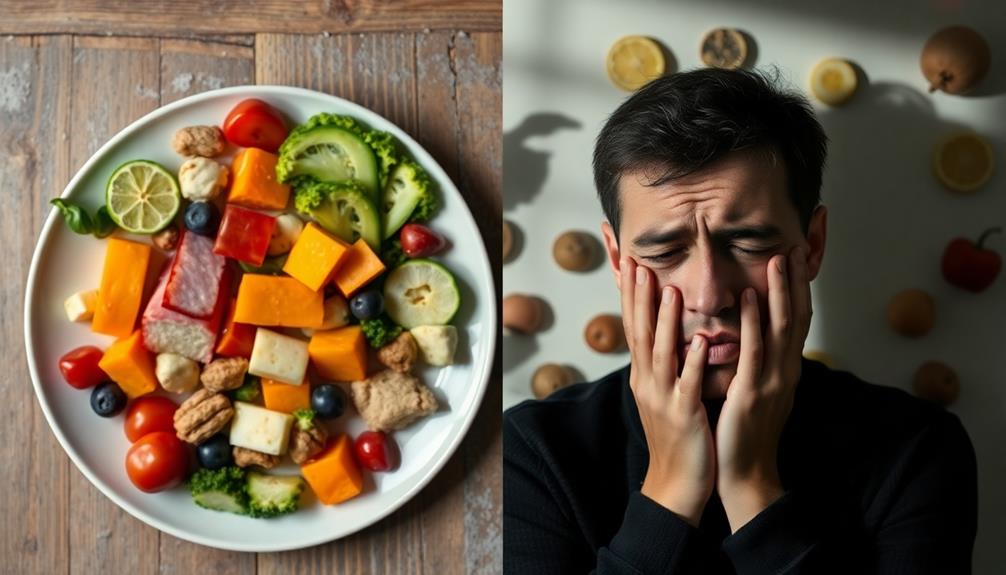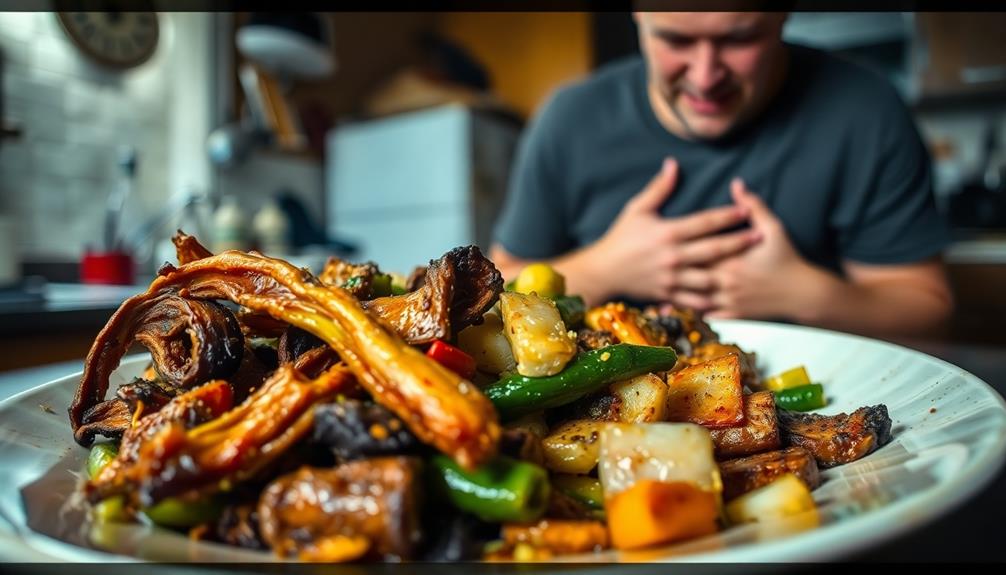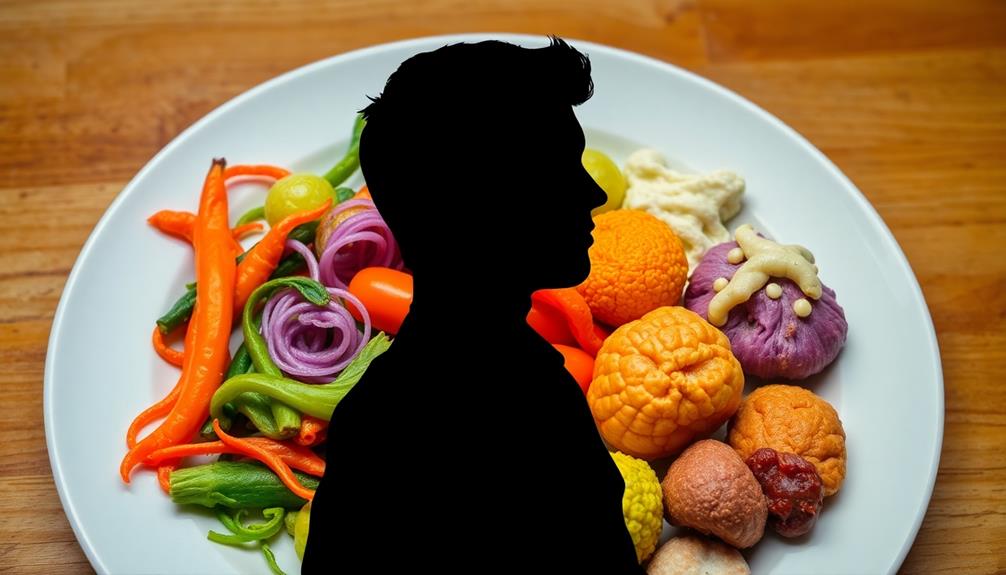Food aversions are complex and often arise from negative experiences tied to specific foods, leading you to instinctively avoid them. This reaction can be intensified by psychological factors such as anxiety or trauma, creating strong emotional responses. Classic conditioning also plays a role; if you associate a food with feeling unwell, your brain triggers a dislike for it. For many, this can lead to nutritional gaps and social isolation. Understanding the reasons behind your aversions can help, and there are effective ways to overcome these challenges. There's much more to discover about transforming your relationship with food.
Key Takeaways
- Food aversions often develop through classical conditioning, linking specific foods to negative experiences or illnesses.
- Psychological factors, such as anxiety and trauma, can significantly contribute to the formation of food aversions.
- Sensory processing issues, particularly in children and individuals with Autism Spectrum Disorder, heighten sensitivity to food textures and tastes.
- Hormonal changes during pregnancy, especially increased GDF15 levels, can trigger sudden food aversions in pregnant individuals.
- Emotional responses play a crucial role in shaping food preferences, influencing both aversions and acceptance of various foods.
Understanding Food Aversions

Food aversions affect many people, manifesting as an intense dislike or avoidance of specific foods that can lead to strong physical reactions. You might experience symptoms like coughing, gagging, or even vomiting when confronted with certain foods.
These aversions can stem from various triggers, including past negative experiences or hormonal changes, especially during pregnancy. For instance, some individuals may develop a strong aversion to certain textures, such as those found in dishes like Mushroom Masala, which can be rich and earthy. If you've got sensory processing sensitivities, you may find specific textures or smells overwhelming, making it hard to enjoy meals.
Food aversions are particularly common among children, pregnant individuals, and those with eating disorders. This can create challenges like nutritional deficiencies and social isolation, impacting your overall well-being.
Psychological factors, such as anxiety, trauma, and mental health conditions, also contribute greatly to the development of these aversions. In fact, your brain may develop food aversions quickly as a survival mechanism, helping you steer clear of substances that could be harmful, especially if they've previously made you feel ill.
Understanding food aversions is essential to addressing them effectively and improving your relationship with food. Recognizing the interplay between sensory processing and psychological factors can pave the way for healthier eating habits.
Causes of Food Aversions

Many factors contribute to the development of food aversions, often rooted in personal experiences and physiological changes. For instance, negative experiences with certain foods, such as the bitter taste of Tella (Traditional Beer), can trigger a strong dislike that generalizes to similar foods. This can be a survival mechanism, helping you avoid potentially harmful items.
Hormonal changes, particularly during pregnancy, may also lead to sudden food aversions, as increased levels of GDF15 can influence your food preferences and cause nausea.
If you have sensory processing issues, especially if you're a child or an individual with Autism Spectrum Disorder (ASD), this can heighten your sensitivity to particular textures and tastes, resulting in more pronounced food aversions. Additionally, those with multiple food allergies often develop lasting taste aversions due to negative reactions to allergens.
Psychological factors, such as anxiety, trauma, and emotional disturbances, play a significant role as well. These factors can affect your willingness to try new foods or even consume items you once enjoyed, leading to patterns associated with avoidant restrictive food intake disorder.
Understanding these causes can help you navigate your relationship with food more effectively.
Symptoms and Reactions

Experiencing food aversions can manifest in various ways, ranging from mild discomfort to intense repulsion. You might find yourself feeling nauseous, gagging, or even vomiting when exposed to foods you've come to dislike. These physical reactions often accompany emotional distress, especially in children, who may feel anxious during mealtime or when faced with disliked foods.
In contrast, embracing seasonal ingredients can promote a more positive relationship with food, as seen in dishes like Nettle and Potato Soup, which can provide a nourishing experience.
When food aversions become severe, they can lead to significant health implications, such as malnutrition and dehydration. You may struggle to maintain a healthy weight, which can exacerbate your overall well-being.
If you're pregnant, you might notice that nearly 70% of individuals report suddenly disliking foods they once enjoyed, likely due to hormonal changes.
These aversions can also trigger avoidant behaviors, pushing you toward restrictive eating patterns. This not only limits your diet but can also impact social interactions, making meals with friends or family feel stressful.
Understanding these symptoms and reactions can help you navigate the challenges that food aversions present, allowing for healthier coping mechanisms and better overall quality of life.
The Role of Classical Conditioning

Classical conditioning plays a big role in how you develop food aversions, often linking a specific food to a negative experience.
For instance, if you try a dish like Red-Braised Pork Belly and later feel unwell, your brain may associate that rich flavor with discomfort.
When you eat something and then feel sick, your brain can create an emotional response that leads to strong dislike for that food.
Understanding these conditioning mechanisms can help you overcome negative associations and broaden your diet.
Conditioning Mechanisms Explained
Understanding how our brains create food aversions can shed light on the powerful role of classical conditioning. This psychological phenomenon occurs when you associate a neutral stimulus, like a dish you once enjoyed, with a negative experience, such as feeling nauseated after eating it. Let's break down how this works:
| Stimulus Type | Example | Outcome |
|---|---|---|
| Neutral Stimulus (NS) | A specific dish | Your brain has no initial reaction |
| Unconditioned Stimulus (UCS) | Food poisoning | You experience illness |
| Conditioned Stimulus (CS) | The same dish after illness | You now feel nauseated at the sight |
| Conditioned Response (CR) | Avoidance of that dish | You develop a food aversion |
The timing of these stimuli is essential; the dish must be eaten right before the illness for the association to form effectively. Negative experiences like food poisoning can lead to rapid food aversions, serving as a survival mechanism. Recognizing this can help in therapeutic settings, where gradual re-exposure can help overcome these aversions.
Emotional Responses to Foods
How do our emotions shape our reactions to food? Your emotional responses can greatly influence your relationship with certain foods, often through a process known as classical conditioning.
For instance, if you'd a negative experience with a specific dish, like a hearty bowl of Champon that made you feel ill, your brain links that unpleasant experience to the food you consumed. This creates a food aversion, making you feel disgusted at the mere sight or smell of that dish in the future.
This classical conditioning involves pairing a neutral stimulus—like the aroma of a specific meal—with an unconditioned stimulus, such as the nausea from your illness. Over time, the neutral stimulus transforms into a conditioned stimulus, prompting a conditioned response of aversion.
The timing of these associations plays a vital role; the closer the negative experience occurs to the tasting of the food, the stronger the aversion you're likely to develop.
These emotional responses can greatly impact your dietary habits and nutritional intake, leading you to avoid certain foods long-term. Understanding this connection can help you recognize how your past experiences shape your current preferences and aversions, ultimately influencing your overall eating behavior.
Overcoming Negative Associations
Overcoming negative associations with food can feel challenging, but it's entirely possible with the right approach. Classical conditioning plays a significant role in how food aversions develop when a neutral food becomes linked to an unpleasant experience, like nausea from a virus.
For example, if someone associates a particular dish, such as bulgogi with a negative experience, it may lead to an aversion to the flavors and textures found in that meal. To break this cycle, exposure therapy can be an effective method.
Gradual exposure therapy helps you re-associate previously aversive foods with neutral or positive experiences. Start by presenting the food in a non-threatening context, perhaps alongside enjoyable activities or familiar flavors. This method weakens the conditioned response, allowing you to see the food in a new light.
Timing is essential; presenting the aversive food shortly before a positive experience can improve your chances of overcoming negative associations.
Integrating Cognitive Behavioral Therapy (CBT) techniques can further support your journey. By challenging the negative thoughts and beliefs tied to the aversive foods, you can reshape your responses and foster acceptance.
With patience and persistence, you can gradually reduce your aversive reactions, paving the way for a healthier relationship with food.
Managing Food Aversions

When it comes to managing food aversions, you'll find that gradual exposure can make a big difference.
By introducing small amounts of the foods you dislike, such as incorporating a hint of traditional Brazilian dishes like Caldeirada or Caruru, you can reduce anxiety and potentially learn to enjoy them.
Pairing these foods with enjoyable activities or flavors can also help create positive associations that encourage you to try again.
Strategies for Gradual Exposure
Gradual exposure is a powerful strategy for managing food aversions, allowing you to confront your dislikes in a controlled manner. Start by introducing small amounts of the aversive food into your meals. This approach helps reduce anxiety and increases comfort over time.
Pairing these foods with enjoyable activities or flavors can create positive associations that facilitate acceptance. For instance, you might discover that incorporating ingredients from Indonesian desserts like Kue Putu or Dadar Gulung can make the experience more enjoyable and less intimidating.
Consider using creative preparation methods to enhance the appeal of the foods you dislike. For example, try altering cooking techniques or incorporating the aversive food into your favorite dishes. This can make the experience more enjoyable and encourage consumption.
Mindful eating practices are also essential. Focus on the sensory experience of eating, paying attention to flavors, textures, and aromas. This mindfulness can improve your enjoyment and further reduce aversion.
If you find it challenging to navigate this process alone, don't hesitate to seek professional guidance. A dietitian or therapist specializing in food aversions can provide tailored strategies and support, helping you overcome obstacles and build a healthier relationship with food.
Embrace gradual exposure, and you might discover a newfound appreciation for the foods you once avoided.
Nutritional Alternatives and Support
Finding suitable nutritional alternatives is essential for anyone struggling with food aversions. By focusing on nutrient-rich options, you can maintain a balanced diet despite your avoidant restrictive food intake. Consulting with a dietitian can help create personalized meal plans that fit your needs.
Here's a quick reference table for nutritional alternatives:
| Aversive Food | Nutritional Alternative |
|---|---|
| Milk | Almond milk or soy milk |
| Wheat | Quinoa or rice flour |
| Eggs | Chia seeds or flaxseed meal |
| Meat | Tofu or legumes |
Creative cooking methods can also help. Blending aversive foods into smoothies or sneaking them into favorite dishes gradually introduces them without overwhelming you. Behavioral strategies, like pairing disliked foods with favored flavors or rewarding yourself after trying something new, can ease your journey towards a more varied diet.
Monitoring your intake is vital, as persistent food aversions may lead to nutritional deficiencies and disordered eating patterns. Regular assessments with healthcare professionals can help you navigate these challenges effectively.
Treatment Options Available

Effective treatment options for food aversions can greatly improve your relationship with food. One effective approach is gradual exposure therapy, where you introduce aversive foods in small amounts over time. This method can considerably reduce your anxiety and help you accept these foods more readily. For instance, incorporating foods like turkey sandwiches made with leftover turkey can make a familiar dish more approachable.
Additionally, Cognitive Behavioral Therapy (CBT) can be beneficial. It encourages you to challenge negative thoughts and beliefs about the foods you dislike, fostering a healthier mindset.
Nutrition counseling with a registered dietitian can also support you in developing strategies for a balanced diet while accommodating your food aversions. Creative food preparation techniques, like altering textures or flavors, can make aversive foods more appealing and enhance your willingness to try them. You might find that experimenting with comforting dishes, such as scalloped potatoes, can help bridge the gap between your aversions and a varied diet.
Don't underestimate the power of community. Joining support groups or attending therapy sessions can provide you with a platform to share experiences and coping strategies. Connecting with others facing similar challenges can alleviate feelings of isolation and motivate you to explore new food options.
Nutritional Considerations

When dealing with food aversions, maintaining a balanced diet is essential to prevent nutritional deficiencies. Traditional Italian dishes, such as Agnolotti, offer diverse flavors and ingredients that can be creatively adapted to suit individual tastes.
Aversive reactions to certain foods can lead to a restrictive food intake disorder, where significant nutrients are avoided altogether. It's important to monitor your overall dietary intake, as severe aversions can result in malnutrition and dehydration, both of which pose serious health risks.
To address these challenges, consider consulting a nutritionist who can help identify alternative sources of necessary nutrients. They can guide you in finding substitutes that align with your food preferences while ensuring you get a variety of essential nutrients.
Gradually reintroducing aversive foods can also be effective. Start by incorporating small amounts of these foods into familiar dishes, making the experience less overwhelming.
Creative food preparation methods can be particularly helpful. By blending aversive ingredients with foods you already enjoy, you can meet your nutritional needs without feeling pressured.
Prevention Strategies

Many parents can benefit from implementing prevention strategies to help children avoid developing food aversions. One effective method is gradual exposure to new foods. Introduce new items slowly and in small amounts, which allows your child to build acceptance without feeling overwhelmed.
Additionally, consider how you present food. Making meals visually appealing or incorporating new ingredients into their favorite dishes can spark their interest and encourage them to try new things.
Role modeling is also essential; when you eat a variety of foods, your child is more likely to explore different tastes and textures themselves. Avoid putting pressure on them during mealtime, as this can lead to anxiety and reinforce picky eating habits.
Here's a quick look at some effective strategies:
| Strategy | Benefits |
|---|---|
| Gradual Exposure | Builds acceptance without overwhelm |
| Creative Presentation | Sparks interest and encourages trying |
| Role Modeling | Positively influences willingness |
| Pressure-Free Environment | Promotes healthier attitudes towards food |
Seeking Professional Help

Food aversions can be challenging to navigate, but seeking professional help can make a significant difference. When you consult a dietitian who specializes in nutrition, you can address dietary gaps and guarantee a balanced food intake despite your aversions. They'll work with you to create a plan that meets your nutritional needs.
Mental health is another essential aspect. Therapists trained in Cognitive Behavioral Therapy (CBT) can help you tackle the negative thoughts and emotional responses tied to your food aversions. By reframing these thoughts, you can develop healthier relationships with food.
Support groups also play an important role. Connecting with others facing similar food intake disorders allows you to share experiences, coping strategies, and encouragement, fostering a sense of community and understanding.
If your food aversions lead to significant nutrient deficiencies or weight loss, a medical evaluation may be necessary. Healthcare providers can recommend further testing or treatment options tailored to your needs.
Frequently Asked Questions
What Type of Psychology Is Taste Aversion?
Taste aversion falls under behavioral psychology. You learn to associate specific foods with negative experiences, leading to strong dislikes. This process highlights how your experiences shape your preferences and responses to different stimuli.
What Pathological Conditions Lead to Taste Aversion?
Certain pathological conditions can lead to taste aversions. You might experience this with food allergies, gastrointestinal disorders, or psychological issues like anxiety. Each condition can create strong negative associations with specific foods you once enjoyed.
Why Is My Body Suddenly Rejecting Food?
Your body might be suddenly rejecting food due to various factors like hormonal changes, illness, or stress. It could also stem from negative experiences linked to certain foods, leading to an instinctual aversion.
How Do Aversions Develop?
Think of a hero avoiding a treacherous path; you develop food aversions similarly. Negative experiences, strong sensory reactions, or even social influences shape your dislikes, causing you to instinctively steer clear of certain foods.
Conclusion
In the dance of flavors, understanding food aversions helps you reclaim your plate. Just like a garden, nurturing your relationship with food can lead to vibrant blooms of enjoyment. By recognizing the roots of your aversions and seeking help, you can transform bitter experiences into sweet ones. Embrace the journey, for each step you take is a brushstroke on the canvas of your culinary life. With patience and care, you can cultivate a harmonious relationship with food once more.









